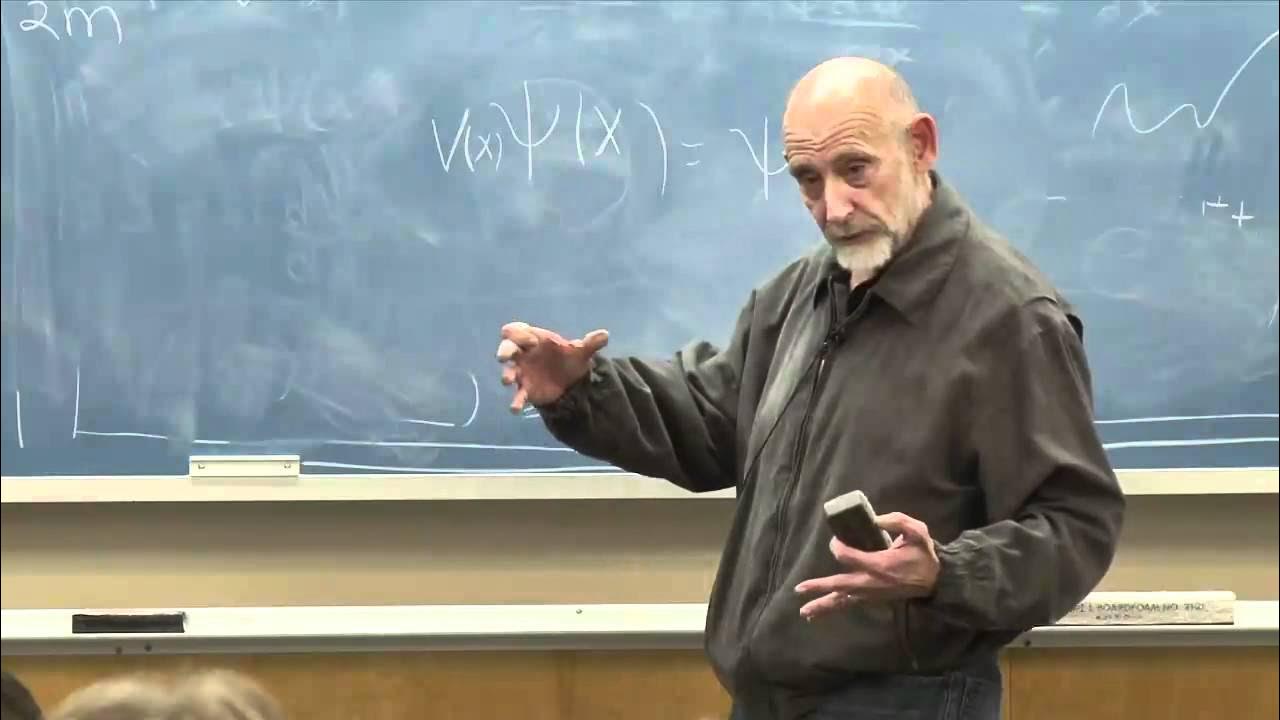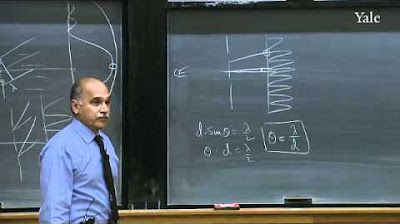Neil deGrasse Tyson Explains The Weirdness of Quantum Physics
TLDRQuantum mechanics, the foundation of modern physics, explores the probabilistic behavior of particles at microscopic scales. The Heisenberg uncertainty principle, introduced in 1927, highlights the inherent limits in measuring a particle's position and velocity simultaneously. This field has revolutionized information technology, enabling advancements in computing, telecommunications, and GPS. Quantum phenomena, such as superconductivity and Bose-Einstein condensates, demonstrate quantum effects at macroscopic scales, while quantum entanglement may even explain bird navigation. Despite its counterintuitive nature, quantum mechanics underpins our daily lives and continues to be a rich area of scientific discovery.
Takeaways
- 🌀 Quantum mechanics governs the behavior of particles on microscopic scales and has led to significant philosophical debates and various interpretations.
- 🚀 The birth of quantum physics in the 1920s introduced concepts that challenged classical physics, such as particles popping in and out of existence.
- 📈 The term 'quantum' comes from Latin, meaning 'how much', and quantum mechanics views objects in terms of probability rather than certainty.
- 🎲 The Heisenberg Uncertainty Principle, introduced in 1927, states that there is a limit to how precisely we can simultaneously measure a particle's position and velocity.
- 💻 The principles of quantum mechanics underpin the information technology revolution, as it allows us to manipulate the electrical properties of silicon.
- 🌐 Quantum mechanics is integral to modern life, with applications in lasers, telecommunications, cryptography, GPS, and many other technologies.
- 🐦 Some bird species may use quantum entanglement to navigate the Earth's magnetic fields during migration.
- 🔬 Quantum entanglement is a phenomenon where particles are linked in such a way that the state of one instantaneously affects the state of another, regardless of distance.
- 🧊 Macroscopic quantum effects, such as superconductivity, superfluity, and Bose-Einstein condensates, demonstrate quantum behavior at larger scales.
- 🔋 Superconductors conduct electricity with zero resistance and repel magnetic fields when cooled below a certain temperature.
- 🌌 NASA's Cold Atom Lab on the International Space Station exploits microgravity to study quantum phenomena that would be impossible on Earth.
Q & A
What is quantum mechanics?
-Quantum mechanics is a branch of physics that studies the behavior of particles on microscopic scales, such as atoms and subatomic particles. It deals with phenomena that are often counterintuitive and have led to many philosophical debates and various interpretations.
When was quantum physics born?
-Quantum physics was born in the 1920s, marking a significant shift in the understanding of the fundamental nature of the physical world.
What is the Heisenberg uncertainty principle?
-The Heisenberg uncertainty principle states that there is an inherent limit to how precisely we can simultaneously measure a particle's position and its velocity. If the uncertainty in position is small, then the uncertainty in momentum is large, and vice versa.
How does the act of measurement affect quantum phenomena?
-In quantum mechanics, the act of measurement always disturbs the object being measured. This is a direct consequence of the Heisenberg uncertainty principle, where the process of reaching for a quantum state inevitably alters its properties.
What is the significance of quantum mechanics in modern technology?
-Quantum mechanics is fundamental to modern technology, particularly in the field of information technology. It allows for the manipulation of electrical properties in materials like silicon, which is essential for the operation of computers and other digital devices.
How does quantum physics apply to everyday devices?
-Quantum physics is applied in everyday devices such as lasers, GPS systems, fluorescent lights, and even toasters. These technologies rely on principles of quantum mechanics for their operation.
What role does quantum mechanics play in the functioning of the global positioning system (GPS)?
-GPS relies on quantum mechanics through the use of atomic clocks aboard satellites. These clocks, which are set and synchronized by ground control stations, allow for the precise timekeeping necessary to determine one's location on Earth.
How does quantum entanglement relate to the navigation of birds?
-Some researchers propose that quantum entanglement may allow certain bird species to sense the Earth's magnetic fields, aiding in their navigation during long-distance migrations. This phenomenon, known as 'spooky action at a distance,' suggests a deep connection between quantum physics and biological processes.
What are some macroscopic quantum effects?
-Macroscopic quantum effects include superconductivity, superfluity, and Bose-Einstein condensates. These phenomena demonstrate that quantum behaviors are not confined to the atomic scale but can also manifest on a larger scale.
What is superconductivity and how does it work?
-Superconductivity is the phenomenon where certain materials conduct electricity with zero resistance and expel magnetic fields when cooled below a characteristic temperature. This occurs because electrons in these materials bind together and form a single quantum mechanical state, allowing for the unimpeded flow of electric current.
How is the Cold Atom Lab on the International Space Station contributing to our understanding of quantum physics?
-The Cold Atom Lab on the International Space Station is using the microgravity environment to create phenomena that would be impossible on Earth. This allows scientists to study quantum behaviors at extremely low temperatures, potentially leading to new insights into the fundamental nature of the universe.
Outlines
🌀 Quantum Mechanics and its Impact on Modern Technology
This paragraph introduces quantum mechanics as the physics domain dealing with microscopic particles like atoms. It discusses the inception of quantum physics in the 1920s and its counter-intuitive nature that led to philosophical debates. The uncertainty principle, introduced by Werner Heisenberg in 1927, is highlighted as a fundamental concept where the act of measurement affects the object being measured. The paragraph emphasizes the role of quantum mechanics in the information technology revolution, explaining how it underpins our modern economy and daily life through devices and systems like computers, lasers, telecommunications, and GPS, which rely on quantum principles for their operation.
🐦 Quantum Entanglement and its Biological Implications
The second paragraph delves into the broader applications of quantum mechanics, including its role in biological processes. It suggests that quantum entanglement might enable birds to navigate Earth's magnetic fields during migration. The concept of quantum entanglement, described as 'spooky action at a distance' by Einstein, is explained as a phenomenon where particles are linked in such a way that the state of one instantaneously affects the other, regardless of distance. The paragraph also touches on macroscopic quantum effects like superconductivity, superfluity, and Bose-Einstein condensates, and mentions NASA's Cold Atom Lab, which studies these effects in microgravity.
📢 Conclusion and Call to Action
The final paragraph serves as a conclusion to the video script, summarizing the enduring mystery and ongoing exploration of quantum phenomena. It invites viewers to support the content by liking, subscribing, and ringing the bell to stay updated with similar educational videos.
Mindmap
Keywords
💡Quantum Mechanics
💡Uncertainty Principle
💡Information Technology (IT) Revolution
💡Lasers
💡Quantum Entanglement
💡Superconductivity
💡Superfluidity
💡Bose-Einstein Condensates
💡Global Positioning System (GPS)
💡Quantum Communication
💡Magnetic Fields
Highlights
Quantum mechanics is the area of physics that deals with the behavior of atoms and particles on microscopic scales.
Quantum mechanics has provoked strong philosophical debates and many interpretations since its inception in the 1920s.
The uncertainty principle, introduced by Werner Heisenberg in 1927, is one of the basic foundations of quantum physics.
Quantum mechanics views objects in terms of probability rather than certainty.
The act of measurement in quantum mechanics can disturb the object being measured.
The modern computer world is based on the principles of quantum physics.
Quantum mechanics has expanded the horizons of modern science and is used in various technologies such as lasers and telecommunications.
Quantum communication is a key technology for secure transmission of information.
The global positioning system (GPS) relies on atomic clocks aboard satellites, which are a result of quantum mechanics.
Quantum physics principles are applied in everyday devices like fluorescent lights, MRI machines, and toasters.
Some bird species may use quantum entanglement to navigate the Earth's magnetic fields during migration.
Quantum entanglement is a counterintuitive physical phenomenon sometimes referred to as 'spooky action at a distance'.
Superconductivity is a quantum mechanical phenomenon where certain materials conduct electricity with zero resistance.
Superfluidity is a state where a liquid loses all viscosity and flows without friction or loss of kinetic energy.
Bose-Einstein condensates are macroscopic quantum phenomena formed at very low temperatures.
NASA's Cold Atom Lab on the International Space Station exploits microgravity to study quantum behavior at macroscopic scales.
Despite being observed over a century ago, quantum phenomena continue to be a subject of ongoing scientific exploration.
Transcripts
5.0 / 5 (0 votes)
Thanks for rating:





